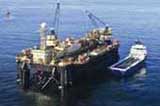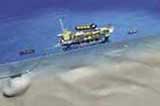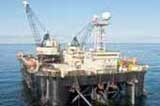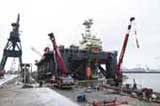
Pipe Laying Vessel - Castoro Sei
Pipe laying of the 1,224 kilometre long Nord Stream Pipeline started in April 2010. Three pipe-laying barges were commissioned to work on the project..
- Saipem's Castoro Sei - for the majority of the route in the Baltic Sea
- Saipem's Castoro Dieci - for the shallow waters in Germany
- Allseas Solitaire - for pipe laying in the Gulf of Finland
Castoro Sei Semi Submersible Pipelay vessel
The Castoro Sei provides a safe, reliable and stable operating platform capable of laying subsea pipelines up to 60 inches in diameter, with additional facilities for offshore construction works and flotel capability. Optional piggyback and dual-lay configurations ensure that the Castoro Sei is capable of installing complex infield pipeline systems in addition to major trunkline systems. The Castoro Sei has an extensive track record of sustained high productivity in both shallow and deep water conditions on major trunkline projects, together with an impressive list of infield projects.
General
The semi-submersible hull construction with optional thruster assistance for enhanced position keeping enable operations to continue in adverse weather conditions. The upper hull encloses the accommodation, main engine room and main store rooms. It is divided transversely by three watertight bulkheads. A large proportion of the main deck is used for pipe storage with a rotating gantry crane mounted on either side of the firing line. The equipment and control systems onboard have been maintained to keep up with current technologies.
Classification
The Castoro Sei is built in accordance with the rules of the Italian Marine Ministry and is classed A1 by the American Bureau of Shipping. The flag state is the Bahamas and the Port of Registration is Nassau. The Castoro Sei also holds a Letter of Compliance issued by the Norwegian Maritime Directorate.
Images Saipem's Castoro Sei
General characteristics Castoro Sei
Classification..
- American Bureau of Shipping
Helideck capacity..
- Sikorsky S-61 N
Dimensions..
- Length overall - 152 m
- Breadth overall - 70.5 m
- Depth to main deck - 29.8 m
- Operational draft (typical) 14 m
- Deck load capacity - 3,600 t
Mooring system..
- Number of anchors/weight - 12 x 25 t
- Anchor wire size - 76 mm (3in) dia
- Anchor drum capacity - 3,000 m each winch
Pipe tensioning system..
- Type of tensioners - Remacut DC electric
- Tensioner capacity - 3 x 130 t each
- Pipe diameter capacity - up to 1.5 m/60in dia
Propulsion positioning system..
- Number of thrusters - 4 azimuthal variable pitch
- Thruster capacity - 2,060 kW/37 t thrust
Pipe abandonment retrieval system..
- Type of winch - Tesmec DC electric
- Winch capacity - 350 t constant tension
Power generation..
- 6 main generators - 20.5 Mw total
- 1 emergency generator - 800 Kw
Cranes pipe handling system..
- Number of cranes - 2 fully revolving
- Crane type - Gantry deck mounted
- Crane capacity - 130 t with 50 m boom
Crew facilities..
- Accommodation capacity - 342 people
Firing line
The firing line comprises the fixed pipelay ramp, enclosed in the central housing, running along the longitudinal centreline of the vessel. It is connected to an internal and external ramp, both of which have adjustable inclination to facilitate pipelay in varying water depths. A ramp extension unit is available for use in deep water or for severe seabed conditions. Located along the fixed and internal ramps are three 110 tonne tensioners, nine work stations (Welding, X-ray and Field Joint Coating) and a number of support rollers.
Double Joint Lines
The pipe double-jointing system with six work stations is located in the deckhouse above the fixed ramp while the transfer and line-up station is enclosed within the superstructure at the stern.
Positioning
The vessel has a twelve point mooring system to facilitate accurate positioning and movement during operations with a fully redundant control and monitoring system. It also has four Azimuthal variable pitch thruster units which can be utilised for propulsion or to further enhance position keeping if required.
Welding
A fully mechanised GMAW system known as "PASSO" is utilised for medium to large diameter pipe in the firing line whilst double joint line welding is accomplished using submerged arc equipment.
Superstructure
An aluminium helideck structure is located at the stern of the vessel. The helideck is designed to accommodate single main rotor helicopters up to and including the Sikorsky S61N type and is approved for use by the UK, Norwegian, Danish, German and Netherlands Civil Aviation Authorities.
Offices and stores are located on either side of the central housing at main deck level. A separate superstructure mounted at the bow of the vessel encloses the bridge, offices, computer room and radio room.
Reference(s) for the images and text, is owned by Nord Stream AG Saipem
Pipe laying Methods
The most common installation methods are the S-Lay, J-Lay, and Reel-Lay methods.
In the S-Lay method, as the laying barge moves forward, the pipe is eased off the stern, curving downward through the water until it reaches the touchdown point. After touchdown, as more pipe is played out, it assumes the "S" shaped curve. To reduce bending stress in the pipe, a stinger is used to support the pipe as it leaves the barge. To avoid buckling of the pipe, a tensioner must be used to provide appropriate tensile load to the pipeline (Clauss,1998). This method is used for pipeline installations in a range of water depths from shallow to deep.
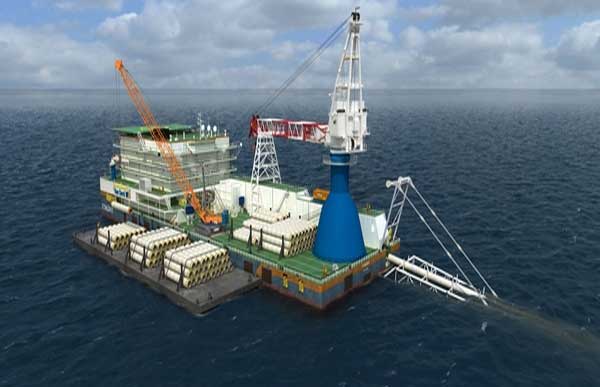 van Oord's Stingray uses the S-Lay method
van Oord's Stingray uses the S-Lay method
In the J-lay method, the pipe is dropped down almost vertically until it reaches touchdown; after that it assumes the "J" shaped curve. J-Lay barges have a tall tower on the stern to weld and slip prewelded pipe sections. With the simpler pipeline shape, the J-Lay method avoids some of the difficulties of S-Laying such as tensile load forward thrust, and can be used in deeper waters.
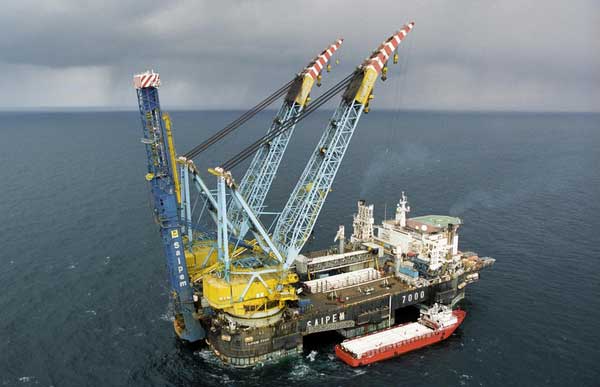 Saipem's 7000 barge uses the J-Lay method
Saipem's 7000 barge uses the J-Lay method
In the Reel-Lay method, the pipeline is installed from a huge reel mounted on an offshore vessel. Pipelines are assembled at an onshore spool-base facility and spooled onto a reel which is mounted on the deck of a pipelay barge. Horizontal reels lay pipe with an S-Lay configuration. Vertical reels most commonly do J-Lay, but can also S-Lay.
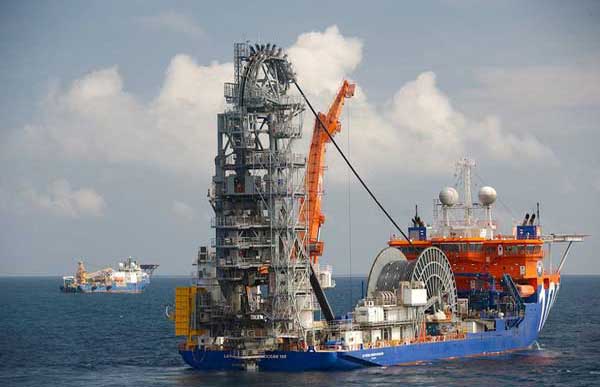 McDermott's North Ocean 105 uses the Reel-Lay method
McDermott's North Ocean 105 uses the Reel-Lay method